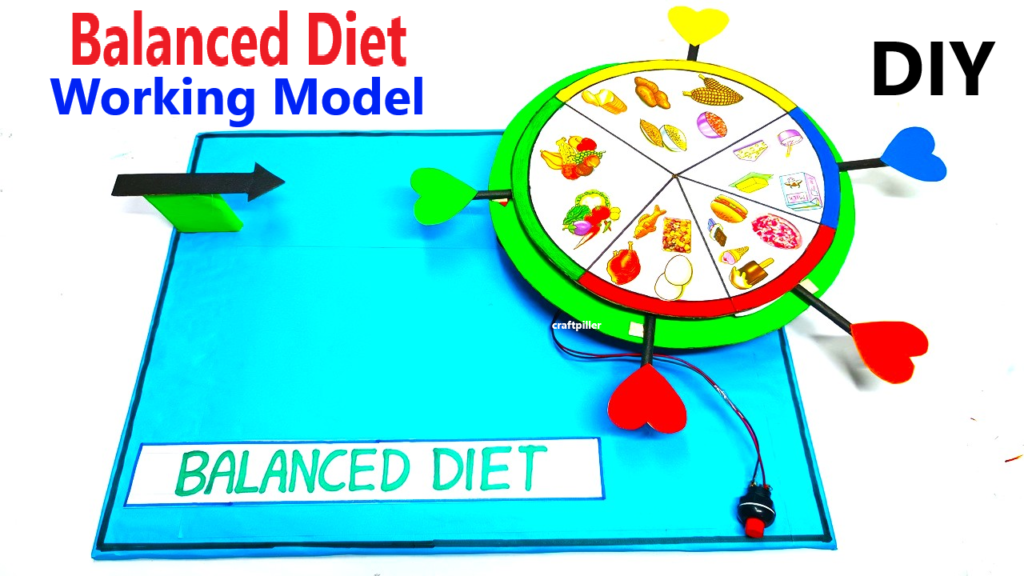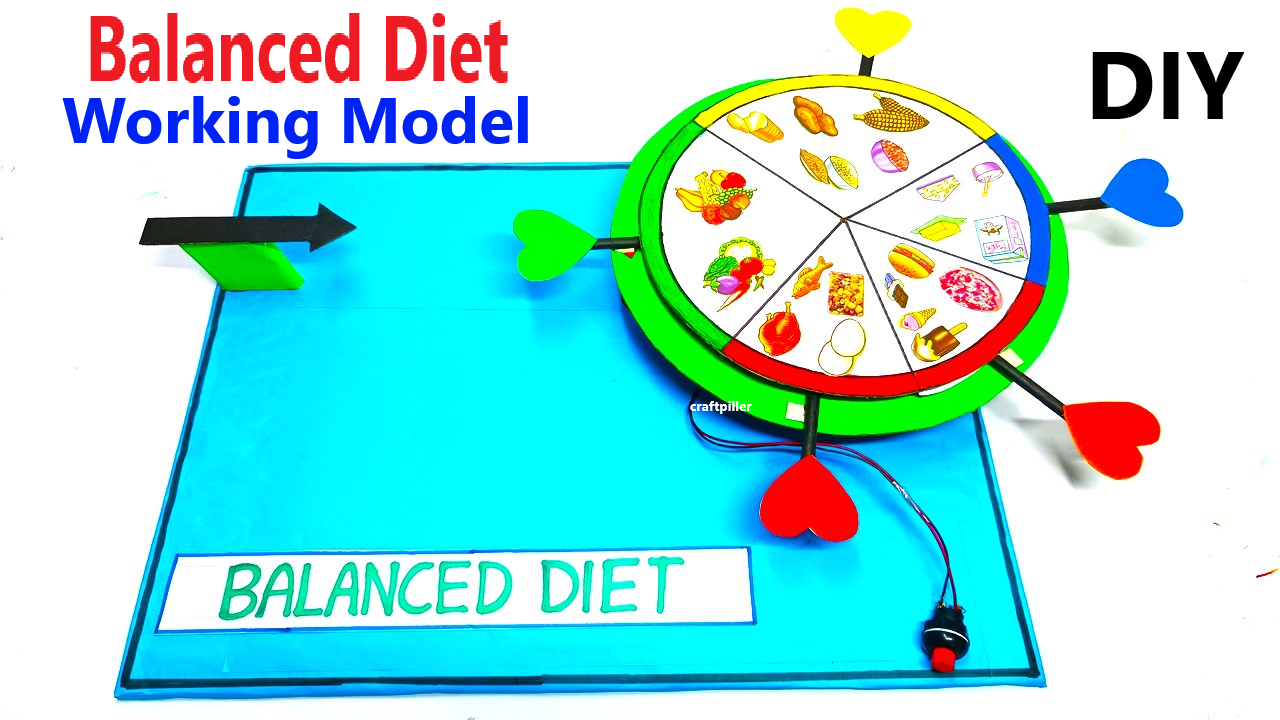Objective:
To create an interactive working model that demonstrates the concept of a balanced diet using a rotating mechanism with an arrow pointer. The model will showcase the different types of food groups that make up a balanced diet, allowing for an engaging explanation of their nutritional roles.

Materials Required:
- Cardboard (for the base and rotating disk)
- Color paper (for creating food groups, labels, and decoration)
- Styrofoam or small ball (for the rotating mechanism center)
- Brass fastener or paper clip (for the rotating mechanism)
- LED lights (optional, to highlight food groups)
- Markers and pens (for labeling food groups and adding nutritional information)
- Scissors, glue, and tape (for assembly)
- Arrow pointer (made from cardboard or color paper)
Steps to Build the Model:
- Prepare the Base and Rotating Disk:
- Cut a large piece of cardboard to serve as the base of your model.
- Cut a circular disk from cardboard, and divide it into equal sections, each representing a food group (like protein, carbohydrates, fats, fruits, and vegetables, dairy, etc.).
- Attach the disk to the base using a brass fastener or paper clip at the center, ensuring that the disk can rotate freely.
- Create the Arrow Pointer:
- Cut a triangular or arrow shape from color paper to represent the pointer.
- Attach the arrow to the edge of the disk with glue or tape, ensuring it points to the different sections of the rotating disk.
- The arrow will rotate with the disk, indicating the various food groups as the disk turns.
- Label the Food Groups:
- Divide the disk into the following sections and label each with a corresponding food group:
- Protein: Meat, fish, eggs, legumes (beans, lentils).
- Carbohydrates: Rice, bread, pasta, potatoes.
- Fats: Nuts, seeds, oils, butter.
- Fruits and Vegetables: A wide variety of colorful fruits and vegetables.
- Dairy: Milk, cheese, yogurt.
- Water: To emphasize the importance of staying hydrated.
- You can decorate each section with pictures of food items related to each group.
- Divide the disk into the following sections and label each with a corresponding food group:
- Add Nutritional Information:
- On or near each section, write brief explanations of the nutritional role each food group plays in maintaining a balanced diet.
- Protein: “Helps build and repair tissues, produces enzymes and hormones.”
- Carbohydrates: “Provide energy to the body, especially for brain function.”
- Fats: “Store energy, help absorb vitamins, and protect organs.”
- Fruits and Vegetables: “Provide essential vitamins, minerals, and fiber.”
- Dairy: “Rich in calcium for strong bones and teeth.”
- Water: “Keeps the body hydrated and aids in digestion.”
- On or near each section, write brief explanations of the nutritional role each food group plays in maintaining a balanced diet.
- Decorate the Model:
- Use color paper and markers to enhance the appearance of the food groups, making them more visually appealing.
- Add arrows or labels to indicate that all food groups should be consumed in appropriate proportions for a balanced diet.
- LED Lights (Optional):
- You can add small LED lights around each section of the rotating disk to highlight the different food groups when the arrow points to them. This will make the model more interactive and visually engaging.
- Final Assembly:
- Once everything is assembled, ensure that the rotating mechanism works smoothly and that the arrow pointer can clearly highlight each food group.
- Place the model on a sturdy base and make sure it is stable for the exhibition.
How It Works:
- Rotating Disk:
- The disk rotates and the arrow pointer moves to each section, allowing you to explain the different food groups.
- You can rotate the disk manually or by using a simple motor mechanism for smoother rotation (if desired).
- Interactive Learning:
- As the arrow pointer lands on each food group, you can explain the importance of that food group in a balanced diet.
- The rotating mechanism will keep the model dynamic and allow viewers to interact with it.
- Balanced Diet Explanation:
- The model helps demonstrate how a balanced diet includes a variety of food from each food group, ensuring that the body gets the nutrients it needs to function properly.
- The model will show that no single food group should dominate, but rather, they should be consumed in the right proportions.

